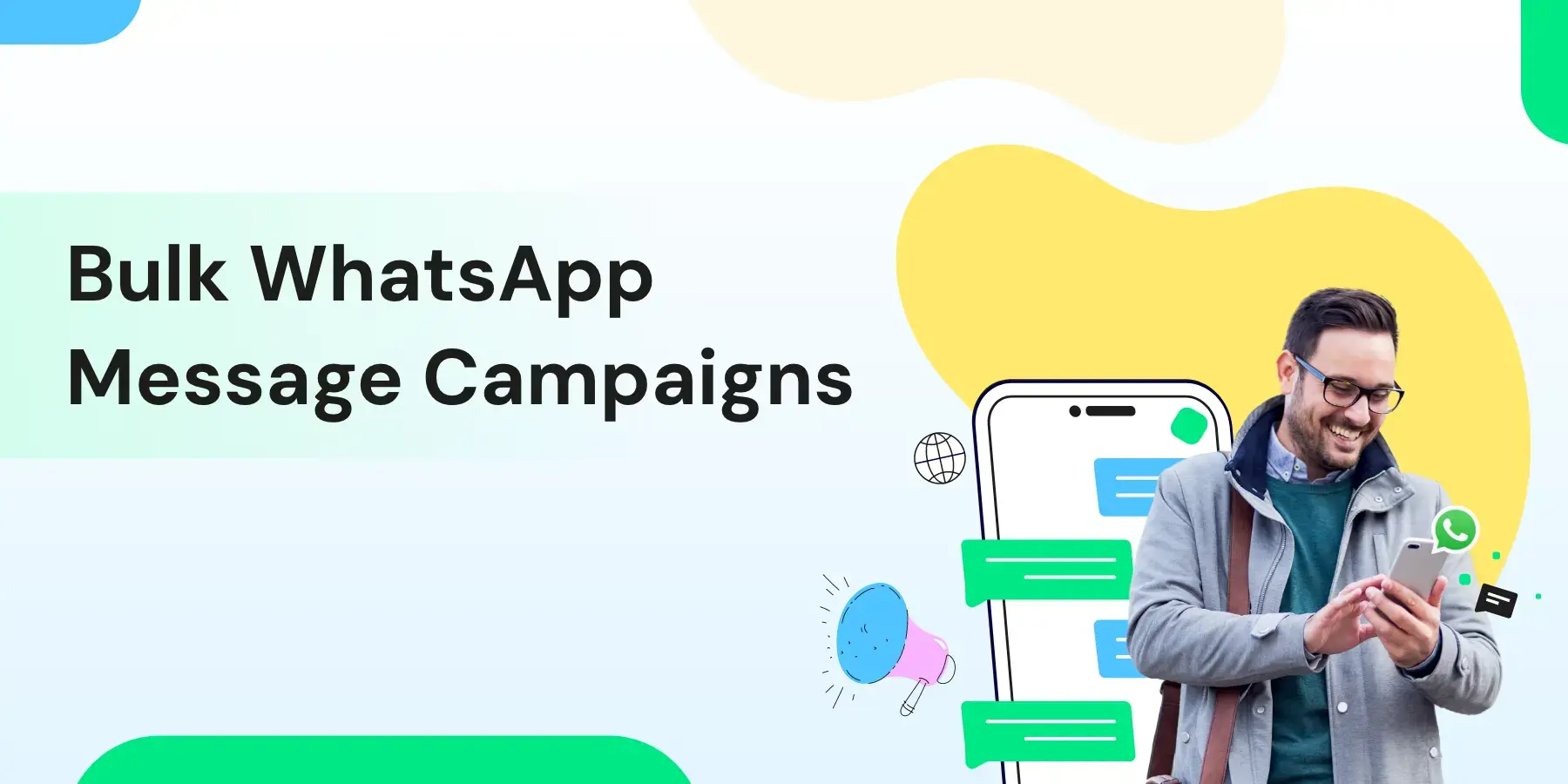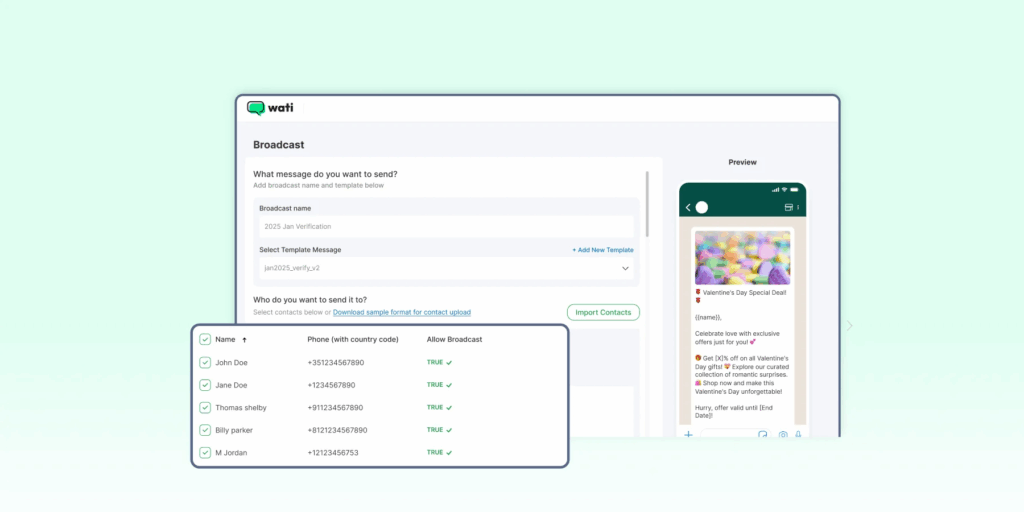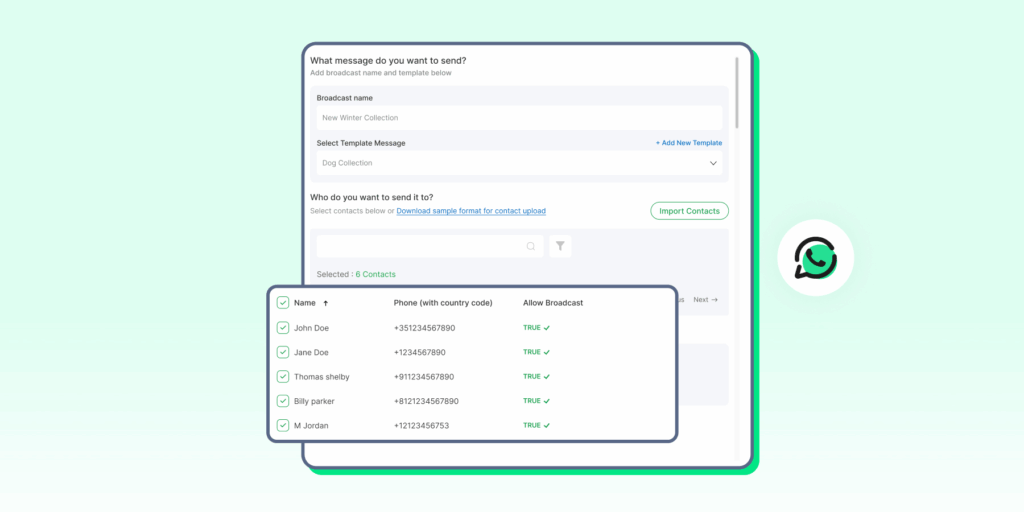
How to Send Bulk WhatsApp Messages in 2026 (Free + Paid Methods)
Written by:
 Ashwin
|
on:
October 9, 2025
|
Last updated on:
November 11, 2025
|
Fact Checked by :
Ashwin
|
on:
October 9, 2025
|
Last updated on:
November 11, 2025
|
Fact Checked by :
 Namitha
|
According to: Editorial Policies
Namitha
|
According to: Editorial Policies
Too Long? Read This First
- WhatsApp Business App’s broadcast lists allow you to send free messages, but each broadcast is limited to 256 contacts and requires recipients to have your number saved.
- WhatsApp Web offers the same functionality with easier typing and formatting, but no extra automation or analytics.
- For businesses handling higher volumes, the WhatsApp Business API allows large-scale sending, scheduling, and analytics, perfect for structured, recurring campaigns.
- Message limits depend on your quality rating. New accounts start with 1,000 daily messages and scale up automatically with consistent engagement and low block rates.
- Compliance matters. Always get opt-in consent, respect opt-outs, and avoid spammy or repetitive content to maintain a strong sender reputation.
- Free methods suit small local operations. For growing teams that require automation, templates, and analytics, the API offers the reliability and scalability to match.
You have implemented a new promotional offer. How do you communicate that with your followers and target audience?
Sending messages one by one to all your loyal audience is an arduous task. Yes, it’s almost impossible for a medium-sized business.
This is where bulk WhatsApp messages come in.
Bulk messaging solves this by allowing you to contact hundreds of customers instantly, while keeping each conversation personal.
This guide explores the intricacies of sending bulk WhatsApp messages, including their types, uses, and strategies for maximizing business impact.
How to Send Bulk Messages on WhatsApp?
You can send bulk WhatsApp messages in three main ways:
- Broadcast Lists (Free) – Send messages to up to 256 contacts using WhatsApp Business App
- WhatsApp Business API (Paid) – Send unlimited messages with advanced features like scheduling and automation
- Third-party tools like Wati – Combines API access with user-friendly campaign management
Each method serves a different stage of growth. If you’re just starting, free broadcasts are enough.
However, once you need automation, segmentation, and compliance at scale, platforms like Wati simplify the entire process: from template creation to tracking campaign performance.
Before diving into the step-by-step methods, let’s first understand what bulk WhatsApp messaging really is and how it works behind the scenes.
What Are Bulk WhatsApp Messages?
Bulk WhatsApp messages allow businesses to send the same message to multiple contacts at once, without starting a group chat. Each person receives the message as a private, one-on-one conversation, keeping replies personal and organized.
When you send a bulk message, it appears just like a direct chat from your business. Recipients can reply individually, and their responses land in separate chats. This makes it easy to maintain privacy while scaling communication.
How to Send Bulk Messages on WhatsApp for Free?
If you are a small business looking to reach customers without spending on software, the WhatsApp Business App gives you a simple way to send bulk messages through broadcast lists.
Method 1: Broadcast Lists on WhatsApp Business App
A broadcast list allows you send a single message to up to 256 contacts at once. As mentioned earlier, each recipient receives it as a private message, not in a group. Here’s how you can create one:
- Open the WhatsApp Business App.
- Tap the three dots in the top-right corner.
- Select “New broadcast.”
- Choose up to 256 contacts from your list.
- Type your message and hit Send.

Only contacts who have saved your number and opted in will receive your broadcast. This is WhatsApp’s built-in safeguard against spam.
Method 2: Using WhatsApp Web
If you prefer typing from your computer, you can create broadcasts on WhatsApp Web as well.
Here is how
- Log in to WhatsApp web
- Click the three dots beside your profile
- Choose “New broadcast,”
- Add your contacts, and send your message.
The same 256-contact limit applies, but it’s easier to compose longer or formatted messages from a keyboard.
Limitations of Free Broadcasts
While the feature is great for basic communication, it has clear limits:
- You can only send to 256 contacts per list.
- There’s no scheduling or automation option.
- Analytics are minimal, showing only delivery and read receipts.
- Recipients must save your number to get your messages.
If your customer list has outgrown these limits or you need automation, personalization, and analytics, the next step is using the WhatsApp Business API through a provider like Wati.
How to Send Bulk WhatsApp Messages Using WhatsApp Business API
Once your audience goes beyond a few hundred contacts, the WhatsApp Business API is the right upgrade.
The WhatsApp Business API is designed for teams that need to scale, automate, and gain visibility.
WhatsApp Business API for Bulk Messaging
The WhatsApp Business API lets you do what the regular WhatsApp app can’t:
- Message thousands of customers at once
- Automate replies and scheduled sends
- Sync conversations with your CRM
- Track real-time metrics like delivery and read rates

But here’s the thing: You can’t access the WhatsApp API directly. It’s available through official providers like Wati or Meta’s Cloud API.
Solutions like Wati are designed with user-friendly dashboards, drag-and-drop tools, and no-code chatbot builders that make every marketing communication easier.
Step-by-Step: Launching Bulk Campaigns with Wati
1. Upload Your Contact List
Import your contact list (CSV) and organize it by:
- Location or region
- Purchase history
- Interests or preferences
- Customer lifecycle stage
- Engagement level
Relevant messages perform better than blanket sends.
2. Create Your Message Template
Craft a clear and engaging message that aligns with your campaign objectives. Choose from:
- Pre-approved templates in Wati’s library
- Custom templates (requires WhatsApp approval)
- Transactional updates
- Promotional offers
- Service reminders
3. Personalize with Dynamic Fields
Make each message unique by adding tokens like:
- {{1}} = Customer Name
- {{2}} = City or Location
- {{3}} = Date or Appointment Time
For example: “Hi {{1}}, we’ve got a special offer for customers in {{2}} this weekend!”
4. Schedule and Send
Choose when to send your campaign: immediately or at a specific time, based on your audience’s time zones. Wati allows easy scheduling so you can reach customers when they’re most active.
5. Monitor Performance
Track real-time metrics including:
- Delivery rate
- Read rate
- Response rate
- Click-through rate (for links)
- Conversion tracking
Use these insights to refine future campaigns.
WhatsApp Bulk Messaging Limits and Quality Restrictions
WhatsApp employs a tiered system to limit the number of users you can reach each day. These limits are in place to protect users from spam and to reward accounts that maintain good engagement and compliance.
Message Limits by Method
| Method | Contact Limit | Rate Limit | Cost |
| WhatsApp Business App | 256 per broadcast | No official limit | Free |
| WhatsApp Business API (New Account) | Starts at 1,000/day | Increases with quality rating | Varies by provider |
| WhatsApp Business API (Established) | Can reach 100,000+/day | Based on the messaging tier | Varies by provider |
Messaging Tiers (API)
Every WhatsApp Business API account falls into one of four tiers:
- Tier 1: 1,000 unique users per day
- Tier 2: 10,000 unique users per day
- Tier 3: 100,000 unique users per day
- Tier 4: Unlimited daily messaging
Your account automatically upgrades tiers as long as your quality rating remains high and you maintain regular messaging activity. In simple terms, the better your engagement, the more people you can reach.
How Quality Rating Affects Messaging
Your quality rating reflects how users interact with your messages. If too many people block or report your messages, your rating drops, and so does your sending capacity.
To keep your account in good standing:
- Send messages only to users who have opted in
- Avoid repetitive or irrelevant broadcasts
- Personalize your communication where possible
- Keep block rates below 2%
- Space out campaigns to avoid sudden spikes
How to Avoid Getting Banned While Sending Bulk WhatsApp Messages?
WhatsApp takes sender reputation seriously. Even one wrong move like sending messages to people who haven’t opted in, can lower your quality score or trigger a ban. Staying compliant is mostly about being transparent, relevant, and using official tools.
- Get Clear Opt-In Consent
Only message people who’ve agreed to receive updates from you. Make the opt-in process explicit, and keep a record of when and how consent was given. - Respect Opt-Outs Immediately
If someone wants to stop receiving messages, honor that instantly. Add a simple “Reply STOP to unsubscribe” line in your messages, and remove those contacts from your lists. - Keep Quality Scores High
Your engagement metrics determine the number of people you can message daily. Keep block rates below 2%, respond to customers quickly, and share content that feels useful, not repetitive or salesy. - Follow WhatsApp’s Content Rules
Avoid prohibited topics, misleading claims, or spam-like formatting. Use approved templates for marketing messages and keep communication relevant to your business. - Use Authorized Tools Only
Send campaigns through verified providers like Wati, which operates on the official WhatsApp Business API. Unofficial apps or automation hacks might look tempting but can permanently restrict your account. - Pace Your Campaigns
Avoid blasting too many messages at once. Space them out and focus on consistency and quality to build long-term sender trust.
Free vs Paid Methods: Which Should You Choose?
Both the WhatsApp Business App and the WhatsApp Business API help you send bulk messages. The difference lies in scale, control, and automation.
| Feature | WhatsApp Business App (Free) | WhatsApp Business API (Paid) |
| Contact Limit | 256 per broadcast | Unlimited (based on tier) |
| Cost | Free | Varies (conversation-based pricing) |
| Scheduling | No | Yes |
| Automation | Limited | Advanced |
| Analytics | Basic delivery stats | Comprehensive metrics |
| Personalisation | Manual only | Dynamic fields |
| Team Access | Single device | Multiple users |
| CRM Integration | No | Yes |
| Message Templates | Not required | Required for marketing |
| Best For | Small businesses, local shops | Medium to large businesses |
When to Use Free Broadcast Lists
If you have fewer than 256 contacts, send occasional updates, and can handle replies manually, the free broadcast feature does the job.
It works well for small businesses like local restaurants, salons, or trainers who want to share simple reminders, offers, or community updates.
When to Upgrade to WhatsApp Business API
Once your customer base grows or you need automation, analytics, and team access, the WhatsApp Business API becomes essential.
It’s ideal for e-commerce brands, education providers, healthcare networks, and service companies that manage hundreds of daily interactions and want reliable delivery at scale.
Ready to scale your WhatsApp messaging?
Wati makes bulk broadcasting simple. It handles everything from contact management to campaign analytics. You can create, schedule, personalise, and track campaigns all in one place, without technical complexity. Book a demo with Wati to see how bulk WhatsApp messaging can transform your customer communication and drive measurable business results.
Frequently Asked Questions
Yes, but only with WhatsApp Business API through authorised providers like Wati. The regular WhatsApp Business App requires contacts to be saved and to have your number saved. With API access, you can upload contact lists and send messages without manually saving each number, as long as recipients have opted in to receive messages.
Use the WhatsApp Business App’s broadcast list feature. Create a new broadcast, select up to 256 contacts, and send your message. This method is completely free but has limitations: recipients must have your number saved, and you can’t schedule messages or access detailed analytics.
Yes, bulk messaging is allowed when done correctly. You must use official channels (WhatsApp Business App or authorised Business API providers), obtain opt-in consent from recipients, send only relevant content, and follow WhatsApp’s Business Messaging Policy. Using unauthorised tools or spamming can result in account suspension.
New WhatsApp Business API accounts start with 1,000 unique users per day. This limit increases automatically to 10,000, 100,000, and eventually unlimited as your quality rating and engagement improve.
For promotional content, 2-4 messages per month works well for most businesses. For transactional or service messages (order updates, appointments), send as needed. The key is consistency without overwhelming recipients. Monitor your opt-out and block rates—if they increase, you’re probably messaging too frequently.
The WhatsApp Business App is free. The API uses conversation-based pricing, where cost depends on the message type (marketing or service) and the user’s country. Wati provides transparent pricing based on official WhatsApp rates.




Latest Comments